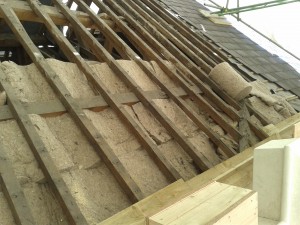The first week of March 2015 saw clear, bright weather for the most part, and it won’t be long before the roof on the North Wing can be clad and made water-tight. The protective tent and the huge amount of supportive scaffolding can then be removed and work will continue within the building. There is still a lot of work to do within the building, and the joiners are leading the way at the moment.
The original, decayed roof was taken off completely and the new timbers have now been bolted into place. This shot was taken from the north-west corner, with the lake off to the right. On the front facing the lake the crenellations, created during the gothicisation of the house in the early-Nineteenth century, are being re-created. The timber work seen here is the basic form for the mock battlements . . . This will then be edged with specially-made glass-fibre copings, which reflect the original profile. These will deflect wind and rain more effectively than the poorly-made original fixtures ever did. A simple plywood template follows the rising contour of the roof as it rises in the centre of the roof-line, and the crenellation is then built to this profile. Modern building regulations apply even to Grade i listed buildings, and insulation is put in place to meet the standards required by law. It is unlikely that the local authority buildings inspector who will be required to sign off the Abbey when work is complete will has ever had to certify quite such an august building. The new timbers have been erected inside the rotten Tudor timbers, which so desperately needed to be replaced. When the new frame is complete the old wood can be completely removed. The chimneys on the North Wing were re-created to exactly match those that had to be demolished. They were built first and the roof’s timber work was created around them. On the east face of the house, where there was less damage to the existing structure, the gothick fenestration details have been created, and the wall has been rendered. New flashing protects the horizontal upper ledge from the weather. The gutters is offset inside the structure of the house, and new flashing has been cut and moulded – in ways which Tudor craftsmen would recognise – to channel rain and snow safely away. The main staircase is being created; this view is from the ground floor. It will lead right up to the top of the building. Made off-site by heritage craftsmen, the new hardwood window frames exactly reproduce the design of the windows put in two hundred years ago for the first Viscount Combermere’s gothicisation project.










